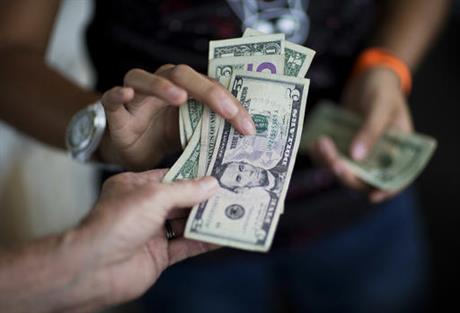- California Assembly OKs highest minimum wage in nation
- S. Korea unveils first graphic cigarette warnings
- US joins with South Korea, Japan in bid to deter North Korea
- LPGA golfer Chun In-gee finally back in action
- S. Korea won’t be top seed in final World Cup qualification round
- US men’s soccer misses 2nd straight Olympics
- US back on track in qualifying with 4-0 win over Guatemala
- High-intensity workout injuries spawn cottage industry
- CDC expands range of Zika mosquitoes into parts of Northeast
- Who knew? ‘The Walking Dead’ is helping families connect
Americans got raise last year for first time since 2007
WASHINGTON (AP) — In a long-awaited sign that middle-class Americans are finally seeing real economic gains, U.S. households got a raise last year after seven years of stagnant incomes. Rising pay also lifted the poorest households, cutting poverty by the sharpest amount in nearly a half-century.
Higher minimum wages in many states and tougher competition among businesses to fill jobs pushed up pay, while low inflation made those paychecks stretch further. The figures show that the growing economy is finally benefiting a greater share of American households.
The median U.S. household’s income rose 5.2 percent in 2015 to an inflation-adjusted level of $56,516, the Census Bureau said Tuesday . That is the largest one-year gain on data stretching back to 1967. It is up 7.3 percent from 2012, when incomes fell to a 17-year low.
Still, median incomes remain 1.6 below the $57,423 reached in 2007. The median is the point where half of households fall below and half are above.
The report “was superb in almost every dimension,” Larry Mishel, president of the liberal Economic Policy Institute, said on a conference call with reporters. “This one year almost single-handedly got us out of the hole.”
Even so, it follows years of tepid pay gains that contributed to widespread political turmoil, driving insurgent presidential candidacies from GOP nominee Donald Trump and Sen. Bernie Sanders. Median household income remains 2.4 percent below the peak it reached in 1999.
The solid gain will likely impact the presidential campaign. Incomes are now higher than in 2009 when President Obama took office.
The Census report shows that the increase was driven by the poorest Americans, who saw the largest increase. Half of the states and Washington, D.C. have increased their minimum wages since 2014, according to the EPI.
Greater competition for low-wage jobs has also pushed up wages. The unemployment rate fell from 6.2 percent to 5.3 percent last year, and 2.4 million Americans found full-time, year-round jobs. That’s forced restaurants and retail employers to lift pay to attract workers.
WalMart, TJX Cos., which owns T.J. Maxx, and the Gap have all announced pay increases in the past two years. Starbucks said in July it would boost pay for all its employees by 5 percent later this year.
Income for the poorest 10 percent of households jumped 7.9 percent last year, while for the wealthiest 10 percent, incomes rose just 2.9 percent. That narrowed the gap between the two groups by the largest amount on record.
The proportion of Americans in poverty also fell sharply last year, to 13.5 percent from nearly 14.8 percent. That is the biggest decline in poverty since 1968. There were 43.1 million people in poverty last year, 3.5 million fewer than in 2014.
Other measures of inequality changed little, however. The gap between the wealthiest five percent of Americans and those right in the middle barely shrank and is wider than it was before the recession.
Another factor fueling the big gain was very low inflation: Consumer prices rose just 0.1 percent, held down by plummeting oil and gas costs. That was the smallest increase since 2009, when consumer prices fell.
Low inflation provided an important boost: A typical price increase of around 2 percent would have reduced last year’s earnings gain to roughly 3 percent, rather than 5.2 percent.
Gas prices have recovered a bit and inflation is running closer to 1 percent this year, so that trend is unlikely to be sustained.
Still, most economists expect paychecks will keep rising this year and finally return Americans to pre-recession levels of income.
“It has been a long slog from the depths of the Great Recession, but things are finally starting to improve for many American households,” Chris Christopher, an economist at forecasting firm IHS said.
Analysts at Sentier Research estimate that median household incomes reached pre-recession levels in July of this year.
In 2015, median incomes picked up in all regions of the United States, across all age groups, and for most ethnic and racial groups.
Latino households recorded the biggest increase, up 6.1 percent, followed by a 4.4 percent gain for whites and 4.1 percent for blacks. Asians, who have the highest median income at $77,166, saw the smallest increase, at 3.7 percent.
Americans are also likely benefiting from an increase in middle-income jobs. Many of the jobs created in the early years of the recovery were in low-paying sectors, such as fast food restaurants and retail.
But according to a report last month from the Federal Reserve Bank of New York, in 2014 and 2015 the growth of middle-income jobs in sectors such as shipping and construction outpaced the gains in lower-paying and higher-paying work.
The Census report also showed that the number of uninsured Americans continued to drop, as people take advantage of President Obama’s health care law.
The share of people in the United States uninsured for the entire year was 9.1 percent, or 29 million people. That’s down from 10.4 percent, or 33 million in 2014.
The report also found that women on average earned 80 percent of the income of men in 2015, a slight improvement from 79 percent in the previous year.
















